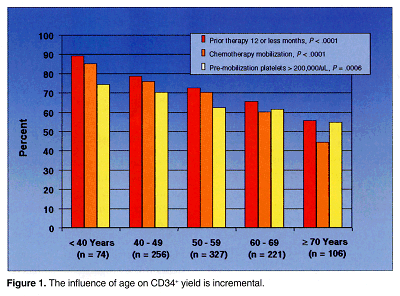Go Directly to Chemotherapy That Will Mobilize Stem Cells Early in Disease Course
LITTLE ROCK-"For the first time, we have shown that with increasing age, the number of stem cells mobilized decreases," said Guido J. Tricot, MD, PhD, reporting the results of a multiple myeloma study (ASCO abstract 1055). Clinicians can
LITTLE ROCK"For the first time, we have shown that with increasing age, the number of stem cells mobilized decreases," said Guido J. Tricot, MD, PhD, reporting the results of a multiple myeloma study (ASCO abstract 1055). Clinicians can compensate for the decrease, however, by using chemotherapy early in the disease course to mobilize stem cells, he advised.
Dr. Tricot is head of the Academic Division of Myeloma Transplant, Myeloma Institute for Research and Therapy, University of Arkansas for Medical Sciences in Little Rock. As part of a study of 984 multiple myeloma patients, the team led by Dr. Tricot looked at peripheral blood stem cell mobilization in 106 elderly patients at least 70 years of age.
"Most clinicians reserve mobilization followed by transplantation for the younger patients and treat the older ones with conventional therapies first, using transplantation only as a last resort. This is the wrong approach because by the time older patients go through conventional therapy, their own resources are depleted," Dr. Tricot said. "They have a much better chance if it’s done earlier. If we can collect stem cells early in the course of multiple myeloma, chances of having a higher platelet count and good outcome are much better, even in older patients."
Favorable Variables
Standard therapy of less than 12 months and platelet count at least 200,000/µL before mobilization were identified by multivariate analysis as favorable variables predicting better outcome. Among patients who had both favorable variables, 85% had adequate collections of at least 4 × 106 CD34+ cells/kg after a median of one collection. Among all 106 elderly patients, 70% had successful collections of at least 4 × 106 CD34+ cells/kg after a median of three collections.
Chemotherapy-based mobilization significantly increased the yield of CD34+ cells compared to growth factors alone, but only in patients who had both favorable variables. "Using growth factors and other agents, we can manipulate the outcome, but one thing we can’t change is the patient’s age," Dr. Tricot said. "The number of stem cells decreases with age, but we can compensate by mobilization with chemotherapy very early in the disease."
Incremental Effect of Age
To determine the influence of age on CD34
+
yield, the investigators applied these same prognostic factors to all 984 patients mobilized during the same time interval. These included 221 patients age 60 to 69, 327 patients age 50 to 59, 256 patients age 40 to 49, and 74 patients under age 40. Increasing age correlated inversely with CD34
+
yield (
P
< .0001), and the effect of age was incremental, with no specific age decade showing acceleration in the decline of CD34
+
yield (see Figure 1).

Other negative prognostic factors included more than 12 months standard therapy before mobilization (P = .0001), less than 200,000/µL platelets before mobilization (P = .0006), and mobilization with growth factors only (P = .0001). After controlling for these unfavorable covariates, age remained significant (P = .0009).
"Using optimal chemotherapy early in the disease can compensate for the patient’s age so that the outcome is just as good as in younger patients," Dr. Tricot said. Increasing age adversely affected CD34+ yield even when premobilization therapy was limited to two cycles. While increasing age did not affect posttransplant neutrophil recovery to greater than 500/µL, it significantly delayed platelet recovery to at least 50,000/µL, when adjusted for CD34+ cells infused. Infusing fewer than 2 × 106/kg CD34+ cells exaggerated this effect, whereas infusing more than 4 × 106/kg CD34+ cells eliminated it completely.
"Most patients over age 70 years mobilize sufficient stem cells for safe autotransplantation, but that collection should occur early in their disease course," Dr. Tricot concluded. "We shouldn’t put elderly patients through extensive early treatment; we should go directly to the chemotherapy regimen that will mobilize stem cells early in the disease. Unfortunately, just the opposite is happening at most centers, which use conventional therapy first instead of aggressive chemotherapy for stem cell mobilization. This is a bad idea."
Navigating AE Management for Cellular Therapy Across Hematologic Cancers
A panel of clinical pharmacists discussed strategies for mitigating toxicities across different multiple myeloma, lymphoma, and leukemia populations.